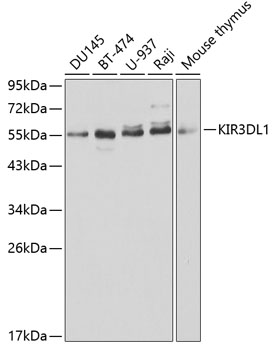Cell Biology Antibodies 6
Anti-KIR3DL1 Antibody (CAB1617)
- SKU:
- CAB1617
- Product Type:
- Antibody
- Reactivity:
- Human
- Reactivity:
- Mouse
- Host Species:
- Rabbit
- Isotype:
- IgG
- Antibody Type:
- Polyclonal Antibody
- Research Area:
- Cell Biology
Description
| Antibody Name: | Anti-KIR3DL1 Antibody |
| Antibody SKU: | CAB1617 |
| Antibody Size: | 20uL, 50uL, 100uL |
| Application: | WB |
| Reactivity: | Human, Mouse |
| Host Species: | Rabbit |
| Immunogen: | Recombinant fusion protein containing a sequence corresponding to amino acids 22-222 of human KIR3DL1 (NP_037421.2). |
| Application: | WB |
| Recommended Dilution: | WB 1:500 - 1:2000 |
| Reactivity: | Human, Mouse |
| Positive Samples: | DU145, BT-474, U-937, Raji, Mouse thymus |
| Immunogen: | Recombinant fusion protein containing a sequence corresponding to amino acids 22-222 of human KIR3DL1 (NP_037421.2). |
| Purification Method: | Affinity purification |
| Storage Buffer: | Store at -20'C. Avoid freeze / thaw cycles. Buffer: PBS with 0.02% sodium azide, 50% glycerol, pH7.3. |
| Isotype: | IgG |
| Sequence: | HMGG QDKP FLSA WPSA VVPR GGHV TLRC HYRH RFNN FMLY KEDR IHIP IFHG RIFQ ESFN MSPV TTAH AGNY TCRG SHPH SPTG WSAP SNPV VIMV TGNH RKPS LLAH PGPL VKSG ERVI LQCW SDIM FEHF FLHK EGIS KDPS RLVG QIHD GVSK ANFS IGPM MLAL AGTY RCYG SVTH TPYQ LSAP SDPL DIVV TGPY E |
| Gene ID: | 3811 |
| Uniprot: | P43629 |
| Cellular Location: | Cell membrane, Single-pass type I membrane protein |
| Calculated MW: | 38kDa/49kDa |
| Observed MW: | 48kDa |
| Synonyms: | KIR3DL1, CD158E1, KIR, KIR3DL1/S1, NKAT-3, NKAT3, NKB1, NKB1B |
| Background: | Killer cell immunoglobulin-like receptors (KIRs) are transmembrane glycoproteins expressed by natural killer cells and subsets of T cells. The KIR genes are polymorphic and highly homologous and they are found in a cluster on chromosome 19q13.4 within the 1 Mb leukocyte receptor complex (LRC). The gene content of the KIR gene cluster varies among haplotypes, although several 'framework' genes are found in all haplotypes (KIR3DL3, KIR3DP1, KIR3DL4, KIR3DL2). The KIR proteins are classified by the number of extracellular immunoglobulin domains (2D or 3D) and by whether they have a long (L) or short (S) cytoplasmic domain. KIR proteins with the long cytoplasmic domain transduce inhibitory signals upon ligand binding via an immune tyrosine-based inhibitory motif (ITIM), while KIR proteins with the short cytoplasmic domain lack the ITIM motif and instead associate with the TYRO protein tyrosine kinase binding protein to transduce activating signals. The ligands for several KIR proteins are subsets of HLA class I molecules; thus, KIR proteins are thought to play an important role in regulation of the immune response. |
| UniProt Protein Function: | KIR3DL1: Receptor on natural killer (NK) cells for HLA Bw4 allele. Inhibits the activity of NK cells thus preventing cell lysis. Belongs to the immunoglobulin superfamily. |
| UniProt Protein Details: | Protein type:Membrane protein, integral; Receptor, misc. Chromosomal Location of Human Ortholog: 19q13.4 Cellular Component: integral to plasma membrane; plasma membrane Molecular Function:HLA-B specific inhibitory MHC class I receptor activity Biological Process: regulation of immune response; immune response; signal transduction Disease: Human Immunodeficiency Virus Type 1, Susceptibility To |
| NCBI Summary: | Killer cell immunoglobulin-like receptors (KIRs) are transmembrane glycoproteins expressed by natural killer cells and subsets of T cells. The KIR genes are polymorphic and highly homologous and they are found in a cluster on chromosome 19q13.4 within the 1 Mb leukocyte receptor complex (LRC). The gene content of the KIR gene cluster varies among haplotypes, although several "framework" genes are found in all haplotypes (KIR3DL3, KIR3DP1, KIR3DL4, KIR3DL2). The KIR proteins are classified by the number of extracellular immunoglobulin domains (2D or 3D) and by whether they have a long (L) or short (S) cytoplasmic domain. KIR proteins with the long cytoplasmic domain transduce inhibitory signals upon ligand binding via an immune tyrosine-based inhibitory motif (ITIM), while KIR proteins with the short cytoplasmic domain lack the ITIM motif and instead associate with the TYRO protein tyrosine kinase binding protein to transduce activating signals. The ligands for several KIR proteins are subsets of HLA class I molecules; thus, KIR proteins are thought to play an important role in regulation of the immune response. [provided by RefSeq, Jul 2008] |
| UniProt Code: | P43629 |
| NCBI GenInfo Identifier: | 1171728 |
| NCBI Gene ID: | 3811 |
| NCBI Accession: | P43629.1 |
| UniProt Related Accession: | P43629 |
| Molecular Weight: | |
| NCBI Full Name: | Killer cell immunoglobulin-like receptor 3DL1 |
| NCBI Synonym Full Names: | killer cell immunoglobulin like receptor, three Ig domains and long cytoplasmic tail 1 |
| NCBI Official Symbol: | KIR3DL1 |
| NCBI Official Synonym Symbols: | KIR; NKB1; NKAT3; NKB1B; NKAT-3; CD158E1; KIR3DL1/S1 |
| NCBI Protein Information: | killer cell immunoglobulin-like receptor 3DL1 |
| UniProt Protein Name: | Killer cell immunoglobulin-like receptor 3DL1 |
| UniProt Synonym Protein Names: | CD158 antigen-like family member E; HLA-BW4-specific inhibitory NK cell receptor; MHC class I NK cell receptor; Natural killer-associated transcript 3; NKAT-3; p70 natural killer cell receptor clones CL-2/CL-11; p70 NK receptor CL-2/CL-11; CD_antigen: CD158e |
| UniProt Gene Name: | KIR3DL1 |
| UniProt Entry Name: | KI3L1_HUMAN |
View AllClose







